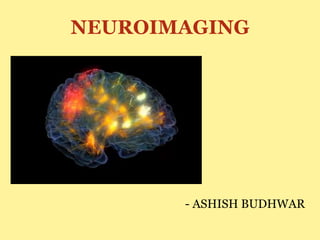
Imaging techniques
- 2. NEUROIMAGING It is the process of imaging the brains structure to assess brain functions and diagnosis. The study of brain is incomplete without imaging the structure of the brain, imaging of the brain is necessary not only for research but also for diagnosing diseases like tumors and lesions. Since conventional X-rays are useless in neuroimaging as the brain consists of more or less similar tissues performing different functions. So better techniques are used in brain imaging.
- 3. TECHNIQUES USED IN BRAIN IMAGING Following methods are useful in brain imaging. 1. CONTRAST X-RAY 2. COMPUTED TOMOGRAPHY 3. POSITRON EMISSION TOMOGRAPHY 4. M.R.I 5. fM.R.I
- 4. CONTRAST X-RAY It involves injecting a substance that absorbs x-rays more or less than the surrounding brain tissues. The injected substance then highlights the contrast between the compartment and the surrounding tissue during x-ray photography. Making the injected area appear different from the surrounding tissue. A good example of contrast x-ray technique is the cerebral angiography.
- 5. CEREBRAL ANGIOGRAPHY This technique involves injecting a radio-opaque dye into a cerebral artery to visualize the cerebral circulatory system during x-ray photography. Cerebral angiograms are most useful to study the brain circulation and localizing vascular damage. Also, the displacement of blood vessels from their normal position also can indicate the location of a tumor.
- 7. COMPUTED TOMOGRAPHY It is revolutionary process founded in 1970s. It combines multiple x-rays to create a combined image of the brain. The machine consists of a cylindrical x-ray tube that projects an x-ray beam through the head on an x-ray detector mounted on the other side. The projector and the detector automatically rotate around the head of the patient at one level of the brain and collect several x-rays which are combined by a computer to generate a CT SCAN. This process is repeated for 5-7 different levels of the patient’s brain to obtain 3-D representations of the brain.
- 8. CT SCAN
- 9. POSITRON EMISSION TOMOGRAPHY It was the first brain imaging technique to provide images of brain activity rather than brain structure. These functional brain images are very much helpful in the study of the brain structure and its functions. In a commonly used method of P.E.T, radioactive Fluorodeoxyglucose (FDG) is injected into the patient’s carotid artery (artery of the neck that feeds the ipsilateral cerebral hemisphere).
- 10. POSITRON EMISSION TOMOGRAPHY Because of the similarity of FDG to GLUCOSE, the primary source of energy to the brain, FDG is rapidly taken up by active cells. But unlike Glucose, FDG cannot be metabolized, so it accumulates in active neurons or in associated astrocytes until it is gradually broken down. The scan therefore images the levels of radioactivity(indicated by color coding) in various parts of the brain.
- 11. POSITRON IMAGING TOMOGRAPHY Therefore, if a PET scan is taken of a patient engaging in some activity, such as reading, after FDG is administered, the PET scan will indicate the areas of the brain that were most active during the activity. PET scan are not the images of the brain, it is merely a colored map of the amount of radioactivity present in the particular area. PET scan is useful in identifying the distribution of the neurotransmitters, receptors and transporters in the brain.
- 12. PET SCAN
- 13. MAGNETIC RESONANCE IMAGING An MRI is a structural brain imaging procedure in which high resolution images are constructed from the measurement of radio frequency waves that hydrogen atoms emit as they align with a powerful magnetic field. An MRI provide better brain structure images than CT. Despite this, the MRI is capable of producing images in 3 dimensions.
- 15. FUNCTIONAL MRI Functional MRI is the use of MRI technology to produce functional images of the brain. fMRI has become the most influential tool of cognitive neuroscience and is widely used for medical diagnosis. Functional MRI produces images representing the increase in oxygen flow in the blood to active areas of the brain. This is possible because of the two attributes of blood in brain which are;
- 16. FUNCTIONAL MRI First, the active areas of the brain take up more oxygenated blood than they need for their energy requirements and thus oxygenated blood accumulates in active areas of the brain. Second, oxygenated blood has magnetic properties that influence the radio-frequency waves emitted by hydrogen atoms in an MRI. The signal recorded by the fMRI is called the BOLD signal which is Blood Oxygen Level Dependent signal.
- 17. fMRI
- 18. ADVANTAGES OF fMRI fMRI has 4 advantages over PET; 1. Nothing is injected in the volunteer/patient 2. It provides both structural and functional images of the brain. 3. It’s spatial resolution is better than PET and CT. 4. It is capable of producing 3-D images of activity over the entire brain.
- 19. DISADVANTAGES OF fMRI The images provides by fMRI are only the images of the BOLD signal which is very complex when related to neural activity. Also the fMRI has poor temporal resolution. It takes 2-3 seconds to measure the BOLD signal and many neural responses such as action potentials, occurs in the millisecond range.
Notas del editor
- A growing tumor can be seen colored red in the second image.